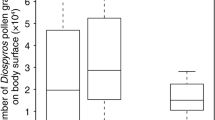Summary
During October and November, 1977, a study of nectar production and nectarivore foraging in Eucalyptus incrassata was conducted at Wyperfeld National Park in south-eastern Australia in order to evaluate the extent to which introduced honeybees (Apis mellifera) compete with native honeyeaters for floral nectar. Data on nectar production, nectar availability, ambient air temperature and the numbers of visiting honeyeaters and honeybees were collected. Most of the daily nectar production in E. incrassata occurs early in the morning when temperatures are too low for insects to forage. In addition, insects, particularly honeybees, are unable to exploit nectar in the youngest flowers because the stamens are clustered tightly around the style. As a result of these temporal and structural characteristics of the flowers, honeyeaters are able to harvest most of the nectar. Honeybees potentially have access to 35–47% of the average daily production of floral nectar in E. incrassata and actually harvest considerably less. These data show that E. incrassata flowers are adapted to restrict insect foragers despite their superficially unspecialized appearance. Eight forest and woodland eucalypts do not have a flower stage which excludes insects and the significance of this difference is discussed.
Similar content being viewed by others
References
Baker, H.B.: Sugar concentrations in nectars from hummingbird flowers. Biotropica 7, 37–41 (1975)
Brody, S.: Bioenergetics and growth. New York: Hafner Publ. Co. 1964
Bureau of Meteorology, Australia: Climatic analysis: Mallee region, Victoria. In: Mallee Region Resources Survey. Central Planning Authority, Victoria (1952)
Bureau of Meterology, Australia: Monthly climatic data—surface, Australia (1970–75)
Carpenter, F.L.: Plant-pollinator interactions in Hawaii: Pollination energetics of Metrosideros collina (Myrtaceae). Ecology 57, 1125–1144 (1976)
Faegri, K., van der Pijl, L.: The principles of pollination ecology, 2nd edn. Oxford: Pergamon Press 1971
Ford, H.A., Paton, D.C.: The value of insects and nectar to honeyeaters. Emu 76, 83–84 (1976)
Ford, H.A., Paton, D.C.: The comparative ecology of ten species of honeyeaters in South Australia. Austral. J. Ecol. 2, 399–407 (1977)
Grant, K.A.: A hypothesis concerning the prevalence of red coloration in California hummingbird flowers. Amer. Nat. 100, 85–89 (1966)
Grant, K.A., Grant, V.: Hummingbirds and their flowers. New York: Columbia Univ. Press 1968
Heinrich, B.: Energetics of pollination. Ann. Rev. Ecol. System. 6, 139–170 (1975)
Heinrich, B., Raven, P.H.: Energetics and pollination ecology. Science 176, 597–602 (1972)
Lyon, D.L.: Territorial and feeding activity of broad-tailed hummingbirds (Selasphorus platycercus) in Iris missouriensis. Condor 75, 346–349 (1973)
Macdonald, J.D.: Birds of Australia. Sydney: A.H. and A.W. Reed 1973
Michener, C.D.: A classification of the bees of the Australian and South Pacific regions. Bulln. Amer. Mus. Nat. Hist. 130, 1–362 (1965)
Paton, D.C., Ford, H.A.: Pollination by birds of native plants in South Australia. Emu 77, 73–85 (1977)
Primack, R.B., Howe, H.F.: Interference competition between a hummingbird (Amazilia tzatical) and skipper butterflies (Hesperiidae). Biotropica 7, 55–58 (1975)
Proctor, M., Yeo, P.: The pollination of flowers. London: Collins 1972
Pryor, L.D., Johnson, L.A.S.: A classification of the eucalypts. Canberra: Austral. Natl. Univ. 1971
Raven, P.H.: Why are bird visited flowers predominantly red? Evolution 26, 674 (1972)
Ribbands, C.R.: The behavior and social life of honeybees. London: Bee Research Assocn. 1953
Scagel, R.F., others: Plant diversity: An evolutionary approach. Belmont, California: Wadsorth 1969
Schwarz, H.L.: Stingless bees (Meliponidae) of the Western Hemisphere. Bulln. Amer. Mus. Nat. Hist. 90 (1948)
Willis, J.H.: A handbook to plants in Victoria. Vol. II Dicotyledons. Melbourne: Melbourne Univ. Press 1972
Author information
Authors and Affiliations
Rights and permissions
About this article
Cite this article
Bond, H.W., Brown, W.L. The exploitation of floral nectar in Eucalyptus incrassata by honeyeaters and honeybees. Oecologia 44, 105–111 (1979). https://doi.org/10.1007/BF00346407
Received:
Issue Date:
DOI: https://doi.org/10.1007/BF00346407




